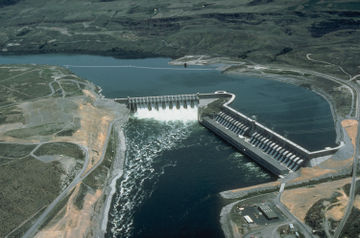Pondage

Pondage is the term for water that can build up behind larger run-of-the-river systems. This is a small amount of water storage where water accumulates during low-demand periods and is used during peak periods when demand is highest. In periods of low electricity demand, or when the plant is inactive the water that would otherwise fall through the spillways and be "wasted" is stored and used when it is needed. Water that is built up in this pondage can result in the elevation of the water varying between 1-1.5 meters during operation.[2] A significant amount of pondage allows the plant to accommodate hourly fluctuations in energy demand.
Since small amounts of water storage in the form of pondage allow run-of-the-river systems to run fully even during off-peak periods, plants with pondage tend to be more efficient than those without.[3]
For Further Reading
References
- ↑ Wikimedia Commons. (December 29, 2015). Chief Joseph Dam [Online]. Available: https://upload.wikimedia.org/wikipedia/commons/6/6c/Chief_Joseph_Dam.jpg
- ↑ Foundation for Water and Energy Education. (December 29, 2015). Types of Hydroelectric Projects [Online]. Available: http://fwee.org/nw-hydro-tours/how-the-northwest-hydro-system-works/types-of-hydroelectric-projects/
- ↑ Electrical Engineering Tutorials. (December 29, 2015). Hydroelectric Plants [Online]. Available: http://www.powerelectricalblog.com/2007/04/hydro-electric-plants-classification.html

